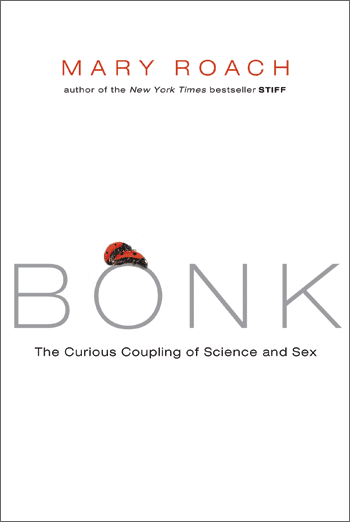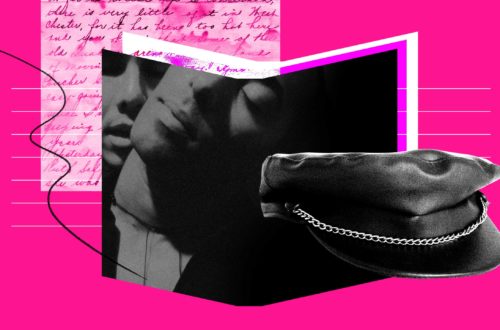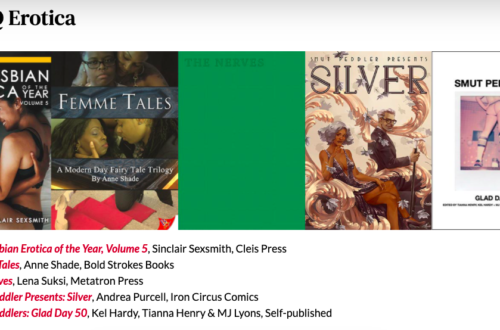
You may remember Mary Roach from the book Stiff: The Curious Lives of Human Cadavers, which made a big splash a few years back, especially relating to her ability to make scientific research incredibly readable and interesting to average folks. She also wrote Spook: Science Tackles the Afterlife. (Her titles, though clever, now after book 3 seem slightly formulaic.)
Now, in Bonk: The Curious Coupling of Science and Sex, she tackles sex. I was intrigued! And what I remember from Stiff is still true: her work is incredibly readable. She makes pig inseminations in Denmark, penis reconstructive surgery in Thailand, and sexual reflex studies in Cairo seem relevant and interesting. I read through chapters on testicles, erectile dysfunction, and penis implants, amused by her stories and laughing, following along with Roach’s investigation of human sexuality.
I kept wondering when gay people would start coming up. Especially when she starts discussing a guy whose genitals were “the size and shape of a navy bean,” (p159) I started wondering if that person was probably in fact intersexed, born with ambiguous genitalia. From what I can tell, this account was in the early 1900s, but I expected Roach to launch into some explanation of why someone might be born with small-to-minuscule genitalia and what and how they would be dealt with today (which would probably be with surgery, although that would depend on the awareness of your doctor). But no: no mention whatsoever of any sort of intersexuality or between-sexes options.
She discusses penile reconstruction and again, no mention of the science behind sex change surgeries like phalloplasties. Page 67 is the first place she even mentions homosexuality, and it’s only in passing, in describing Princess Marie whose husband, Prince George of Greece, was “a latant homosexual.” By page 188, her 2nd mention of homosexuality in parenthesis – “He had never had sex, never had a girlfriend (or boyfriend)” I was beginning to suspect that Roach doesn’t think of homosexuality as more than a tiny side-note.
Then, after reading through three chapters on male reproductive functions specifically (testicles, erectile dysfunction, and penis implants), we get to two chapters on women, “The Lady’s Boner: Is the Clitoris a Tiny Penis?” and “The Prescription-Strength Vibrator: Masturbating for Health.” She mentions a clit pumping device, and I found myself yet again thinking, wow, this subject leads directly into the field of trans men who opt against genital surgery but whom enhance their genitals – often their clit – with a small penis pump (or large clit pump) and encourage their clit to get larger, to become a tiny penis. That stuff is fascinating, and wouldn’t it be great if she lent her investigation, research, and accessible writing skills to that subject?
But again, no. No mention of anything remotely related. I know, these topics could absolutely be books unto themselves, but that she either a) ran into the material and deemed it completely unimportant, as to not even warrant a mention, or b) did not run into these studies or material at all, makes me think that she either wasn’t looking very hard or was deeply heterocentric in her research. If she did run across it, why not mention it? She didn’t have to go into the subjects in depth, especially because the topics of trans, gender, and homosexuality obviously intersect in well, pretty much every single place along the study of sexuality, but simply some acknowledgment of these things existing is, I think, necessary.
So, this is what I’m thinking about halfway through the book. I keep reading the chapters on the female genitals, and then the science of orgasm, and I come across female ejaculation in a footnote. I kid you not, the ONE AND ONLY time she mentions female ejaculation is in a footnote. A FOOTNOTE! A long footnote, comparatively, but still! Isn’t there more science to female ejaculation than simply one footnote? Maybe not – maybe that one footnote is seriously the only scientific study she could find on female ejaculation. But hey, isn’t that significant? Isn’t that an interesting cultural commentary on sexuality, where she’s spent almost an entire chapter on male ejaculation, sperm count, what it is made of, how far it shoots, how much comes out?
But Roach skips over all of this.
She does note, in a footnote again, on p197, that there are “351 ways to say penis … and only three for clitoris: bean, button, and the little man in the boat.” She goes on to make note that the “authors [of this study] felt this reflected society’s disregard of human pleasure, which is probably true, but I simply bemoan the lack of useful synonyms.” Well, the reason there aren’t ‘useful synonyms’ reflects the value in the culture, doesn’t it? It’s not as though we have any shortage of small, round objects in our lives – pennies, marbles, pearls, gemstones, pebbles come to mind. So what does it reveal about a culture that we don’t have a language to describe the primary source of female sexual pleasure?
That’s not what Roach is writing this book for, though, clearly. As I got into the last third of the book, though, I had to wonder: why is Roach writing this book? What’s her point? She doesn’t seem to do much except summarize scientific sex studies with a distinct lack of feminist, gender-positive, sex-positive (see chapter 10, “Masturbating for Health,” and her implied judgment when mentioning “Mr. Fred Jelly Dongs” and “Vibrating Port-A-Pussies” as examples of sex toys), and trans-inclusive perspectives. As I kept reading, I found myself wondering why it was I was trusting this person’s perspective, considering that clearly our values were in such different places.
By the end of the book, much as I had enjoyed her witty writing, I was convinced of it. She begins the last chapter describing a Masters and Johnson study called Homosexuality in Perspective in 1979, which actually addresses directly what lesbian and gay men do in sexual partnerships and how it compares to hetero couples. The penultimate paragraph, though, takes a turn for the worst when Roach writes:
Sadly, the main thing people recall about Homosexuality in Perspective … is that Masters and Johnson spent the second half of the book touting a therapy for helping homosexuals convert to heterosexuality. The team went out of their way to assure readers that they screened clients carefully, accepting only those who had turned to homosexuality after a traumatic experience with heterosexuality (rape or abuse, for instance).
… But let’s give Masters and Johnson their due. … The laboratory study of sex has never been an easy, safe, or well-paid undertaking.
Yes, they are due some credit in modern sexuality studies, certainly. But hey, why don’t we address this blatant homophobia? Is Roach assuming that we are so far beyond homophobia in our culture, and in her readership, that we don’t even need to address how damaging and dangerous perspectives like those are? Perhaps Masters and Johnson were under other pressures from homophobic fundors, perhaps there were political difficulties getting human subjects review board approvals for seemingly “encouraging” homosexuality – there could be various explanations for why they spent half of their book discussing the “cure” and how to “convert” homosexuals.
And then, to end the entire book with these paragraphs, given the blatant disregard of gay and lesbian sexuality, sex-positivity, or progressive gender understandings, leaves me with an awful sense of injustice.
Mary Roach, I love your writing. I really do. But there were many ways to validate and acknowledge perspectives that you do not understand without actually incorporating our experiences into your study of human sexuality. You were so very broad that you missed some huge, gaping holes. Hope your next study is more honed, thoughtful, and inclusive.




Thank you so much for reviewing this book! I loved Stiff, which actually posed interesting questions about how we handle death and decomposition, even if she didn't offer any real critique. Bonk sounds like a waste of time…I'm not in the mood to have a one-sided yelling match with a pile of wood pulp so soon after graduation.